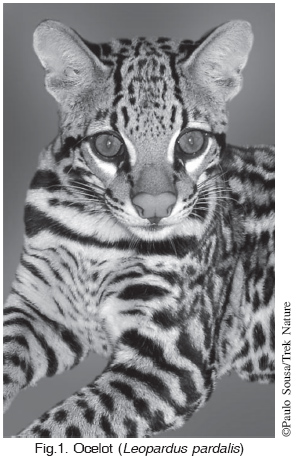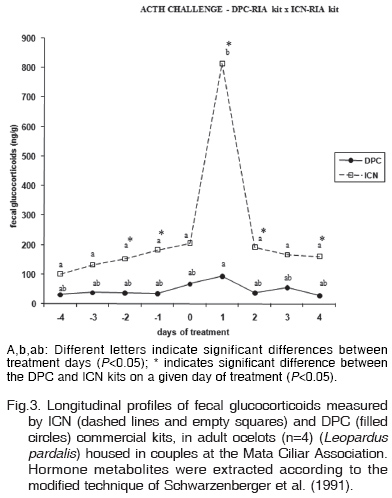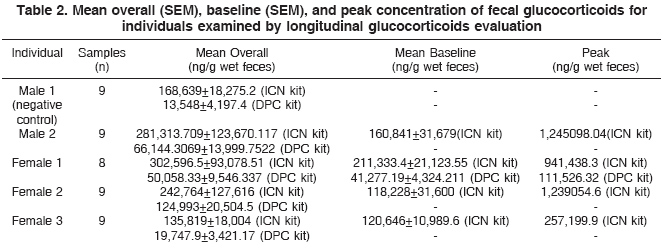The ocelot (Leopardus pardalis) is included in list of wild felid species protected by CITES and is part of conservation strategies that necessarily involve the use of assisted reproduction techniques, which requires practical and minimally invasive techniques of high reproducibility that permit the study of animal reproductive physiology. The objective of this study was to compare and validate two commercial assays: ImmuChem Double Antibody Corticosterone 125I RIA from ICN Biomedicals, Costa Mesa, CA, USA; and Coat-a-Count Cortisol 125I RIA from DPC, Los Angeles, CA, USA, for assessment of fecal glucocorticoid metabolites in ocelots submitted to ACTH (adrenocorticotropic hormone) challenge. Fecal samples were collected from five ocelots kept at the Brazilian Center of Neotropical Felines, Associação Mata Ciliar, São Paulo, Brazil, and one of the animals was chosen as a negative control. The experiment was conducted over a period of 9 days. On day 0, a total dose of 100 IU ACTH was administered intramuscularly. Immediately after collection the samples were stored at 20C in labeled plastic bags. The hormone metabolites were subsequently extracted and assayed using the two commercial kits. Previously it was performed a trial with the DPC kit to check the best extraction method for hormones metabolites. Data were analyzed with the SAS program for Windows V8 and reported as means ± SEM. The Schwarzenberger extraction method was slightly better when compared with the Wasser extraction method (103,334.56 ± 19,010.37ng/g of wet feces and 59,223.61 ± 12,725.36ng/g of wet feces respectively; P=0,0657). The ICN kit detected an increase in glucocorticoid metabolite concentrations in a more reliable manner. Metabolite concentrations (ng/g wet feces) on day 0 and day 1 were 66,956.28 ± 36,786.93 and 92,991.19 ± 28,555.63 for the DPC kit, and 205,483.32 ± 83,811.32 and 814,578.75 ± 292,150.47 for the ICN kit, respectively. The limit of detection for the ICN kit was 7.7 ng/mL for 100% B/Bo (25ng/mL for 88%B/Bo) and for the DPC kit it was 0.2ug/dL for 90.95% B/Bo (1ug/dL for 81.27% B/Bo). In conclusion it was confirmed that the Schwarzenberger extraction method and the ICN kit are superior for extracting and measuring fecal glucocorticoid metabolites in ocelot fecal samples.
Stress; Leopardus pardalis; ocelot; ACTH challenge; fecal glucocorticoid






